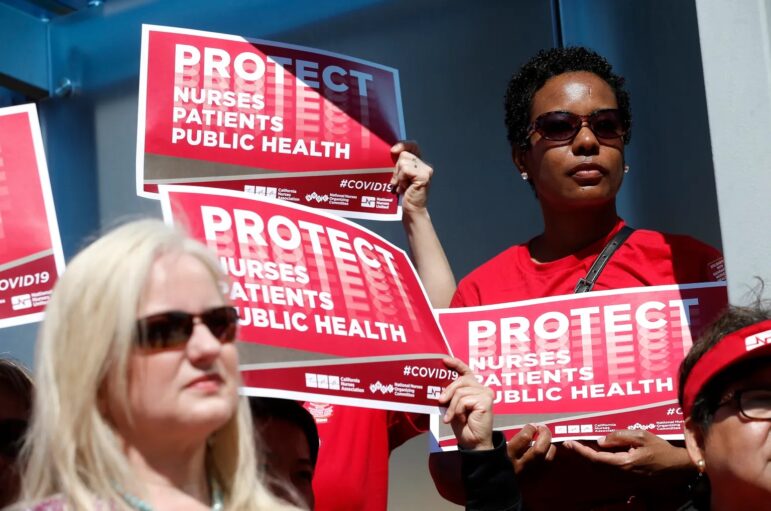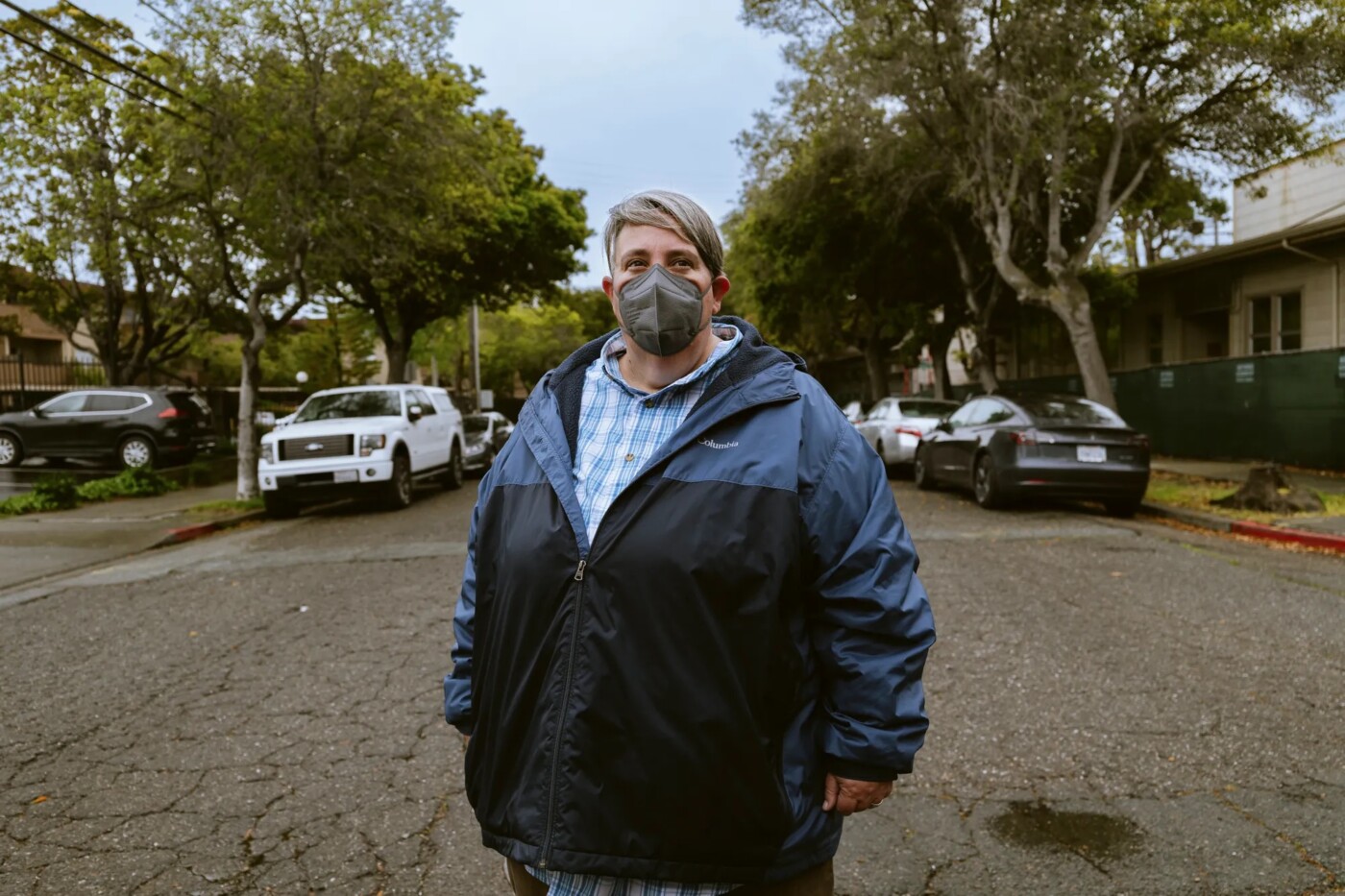For months California disability and labor advocates have been attempting to preserve statewide masking requirements in health care settings.
But with the sunset of one of the last remaining COVID-19 mandates, they say people who are the most vulnerable to severe illness now have to make an “impossible choice” — risk getting the virus at a doctor’s office, or avoid necessary health care.
On April 3, the California Department of Public Health ended masking and vaccination requirements in high-risk settings, including health care facilities, jails, prisons and emergency homeless shelters.
Now, instead of statewide rules, it’s up to local health departments and individual facilities to decide whether to mandate masks. The department says it gave facilities a month of lead time to develop those internal policies. California’s three-year state of emergency ended in February.
But Raia Small, an organizer with Senior and Disability Action, said the department’s announcement that it was going to end masking requirements came as a shock. She said the group met with top department officials multiple times, as recently as January, and was told there was “no plan to stop masking requirements in health care.”
“I emailed them and let them know how upset we were, especially since we had been in communication with them and this came out with no warning,” Small said. “They haven’t responded.”
Other groups, including the California Nurses Association and Disability Rights California, have also been vocal in their opposition to the state’s new policy, or lack thereof. People with disabilities or chronic health conditions face higher risk of COVID-19 complications and interact with the health system more frequently than average, they say.
Elizabeth Zambelli, a San Francisco resident, is one such patient. She has multiple health conditions and is on medication that suppresses her immune system. Typically, Zambelli spends several days a month at the doctor’s office or in the hospital.
“I’m not going to go in unless it’s an emergency because I’m at risk for complications from COVID,” Zambelli said.
Nurses and other health care workers also have no choice but to risk exposure. They have raised alarms about their safety throughout the pandemic, including access to masks and testing, and say this latest change is a “failure” of public health officials.
“They are supposed to be protecting the public. For them to abandon the standards is counterproductive,” said Zenei Triunfo-Cortez, co-president of the California Nurses Association and National Nurses Organizing Committee.
State epidemiologist Dr. Erica Pan told CalMatters “strong statewide consistency” was crucial in the early days of the pandemic when severe disease and death rates were high and little was known about the virus. But today, she said many things have changed, including vaccination and herd immunity levels, the behavior of different viral variants and the reliability of certain data like unreported over-the-counter tests, making standardized statewide requirements less workable.
“Now, there just is such a variability … in geography, local transmission, the types of patients people are seeing, the needs of the facility, the ventilation of the facility. So I think those are all considerations that are really hard to standardize statewide,” Pan said in an interview Monday with CalMatters.
The state health department is basing its current guidance for masking in health care facilities on the federal Centers for Disease Control and Prevention’s COVID-19 Community Levels.

The CDC guidelines “strongly recommend” wearing masks during periods of high transmission, but do not offer guidance for health departments or employers to institute masking requirements. A scientific summary describing how the CDC developed its Community Levels indicator notes that masks are primarily intended to prevent infectious people from spreading COVID-19 to others while offering some protection to the wearer, meaning they are most effective in high-risk settings when everyone is masked. The summary does highlight, however, that new strains of the virus are less likely to cause severe illness, making relaxed guidelines more feasible.
The only remaining statewide COVID-19 protocol is a five-day isolation period, down from 10 days, if someone tests positive for the virus but has improving symptoms.
Pan said health systems wanted more autonomy over internal infection control procedures, which is typical for other respiratory diseases such as the flu. For example, during flu season many facilities require unvaccinated employees to wear masks.
“Health care facilities know exactly where their most vulnerable populations are and they can really customize their plans,” Pan told CalMatters. “And that’s what we have heard has been happening actually, that a lot of systems have updated some requirements in their facilities.”
But that’s exactly what vulnerable patients like Zambelli say is the problem. She has tried talking to her health care team about requiring universal masking at their facilities but has been told that they are following state and local guidelines.
“That’s why it’s really important for CDPH, San Francisco public health and other departments to be the ones to set this policy,” Zambelli said. “It’s terrible to put people in a position where people have to ration care because they have to decide if they can safely access that health care.”
Most counties and health care facilities such as hospitals have been swift to follow the state’s lead, with the five largest health systems dropping mask mandates for employees and patients except in instances where local health departments have retained mask requirements. Sutter Health, University of California Health and Dignity Health all told CalMatters masks are “strongly recommended” but not required in most instances, in keeping with state and local policy. Kaiser Permanente and Providence did not respond to questions but updates to their websites indicate masking has been dropped.

Los Angeles and San Francisco counties have the strictest local requirements, with health workers of all types still required to wear masks. Alameda and Contra Costa counties are requiring masks in nursing homes, and Santa Clara County announced masks will be required next winter, when respiratory virus transmission is high.
Advocates said they are particularly frustrated that the state has not created or published criteria that would trigger new masking orders. The state Department of Public Health has shied away from setting such thresholds since the state’s controversial and confusing multi-tiered pandemic recovery plan ended in July 2021.
“We wanted a timeline or a metric for changing the requirement — cases are at this level or test positivity is at a certain level. They refused to give any kind of scientifically based guidelines,” said Small, with Senior and Disability Action.
Pan said the state health department learned from its “incredibly complex” pandemic recovery plan that tying policies to thresholds for cases or transmissions does not always reflect the actual impact on a local hospital’s capacity. As more testing has shifted to non-reportable over-the-counter tests, data that could be used for benchmarks has also become less reliable.
“It’s challenging to come up with something that we can say ‘This particular data is going to absolutely have the best correlation with what the impact is in this hospital, for example, or in this community,’” Pan said.
Future state policies will be based on the COVID-19 SMARTER plan, which was released in February 2022, the public health department said. The plan lays out preparedness and response actions, such as maintaining a stockpile of masks and vaccines, but does not include indicators to trigger action.
According to CDC data, all counties in California, and most of the country, have low transmission levels. However, cases are likely undercounted, with average testing rates in California reaching lows not seen since the early days of the pandemic when testing was severely limited by supply and laboratory capacity.
“When you look at the number of hospitalizations per day, we were doing better one year ago than we are right now. So there’s no data-driven rationale,” said Dr. Noha Aboelata, CEO of Roots Community Health Center in Oakland.
The most recent state data shows the 14-day daily average for COVID-19 hospitalizations is more than 1,600, compared to about 1,300 at the same time last year.
Aboelata said if the state is going to rely on a “do-it-yourself public health approach,” it needs to tell the public about any COVID outbreaks at facilities and publish information about facility policies. Aboelata said she would not refer vulnerable patients to providers who are not enforcing masking, especially since health care providers have a responsibility to keep patients safe and incorporate new science into their practice. The Roots clinic will continue to require universal masking.
“When we learned about blood-borne pathogens, we wore gloves. Gloves suck, they’re uncomfortable, some people are allergic to them, and you can’t feel what you want to feel,” Aboelata said. “They’re not awesome, but we do it…I think we need to do the same thing here.”
Beth Kenny, a patient in Alameda, said the termination of masking requirements is “devastating.” Kenny has Crohn’s disease, which requires monthly drug infusions that suppress the immune system. Kenny is enrolled in an internal Kaiser Permanente study on the effectiveness of the COVID-19 vaccine and said the data shows their body isn’t able to produce protective antibodies.
They are trying to switch insurance providers to get treatment at a county facility that still requires masking, but that would cost an additional $1,000-plus per month.
“It’s hard to feel like there’s any value in my life in these policies,” Kenny said. “I feel pretty devastated, pretty alone, and gaslit by our political leaders and public health leaders.”
